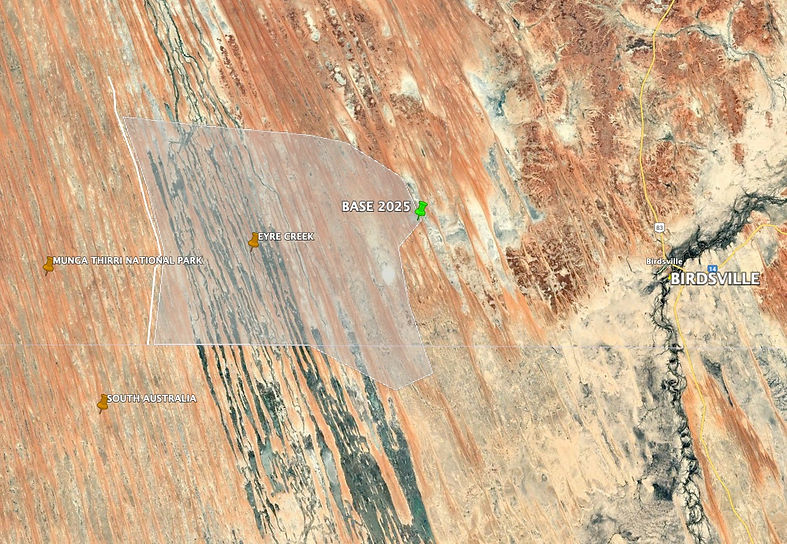Watti Watti/Munga-Thirri NightSky

Photo - Carolyn Larcombe
Watti Watti/Munga-Thirri NightSky
7 Day Survey - May 30 > June 5, 1 day 4WD/5 days trekking/1 day 4WD
Survey grade:
Survey price: $5460 Fully Booked - waitlist only
We will be walking in Munga-Thirri, Big Sandhill Country, the traditional land of the Wangkangurru people, many of whom reside in Birdsville.
What is the main focus of this survey?
This survey, though limited to just five walking days, serves as an important precursor to the following Munga-Thirri Expedition. Due to the extensive floods in Eyre Creek, we will be spending the entire trek on Adria Downs, on the eastern side of the creek. Please note that Adria Downs is an active cattle station and we may encounter evidence of cattle during our trek, though at 8,750 square kilometres, any encounter would be brief and sparse. We intend to spend nearly all of the time along the floodplain, which will be lush with life, particularly birds. In addition to the floods, the entire area has received huge rainfall, so the surrounding dune fields and open corridors will be covered in wildflowers, hence the focus will be on conducting a comprehensive flora and birdlife survey along the Eyre Creek floodplain.
What’s the NightSky Component?
The survey coincides with the new moon phase, creating ideal conditions for stargazing. During this time, the Galactic Centre, or Galactic Bulge, of the Milky Way will be visible. To enhance this experience, we’ll have our telescope on hand, guided by our resident astronomer and cameleer, Thomas.
This region of Munga-Thirri features a striking mix of towering red dunes, expansive claypans, and dense forests of Acacia georginae (gidgee).
Walking here involves traversing firm sand, with soft sand encountered primarily at the dune crests. Due to the massive rain event, the landscape will have transformed into a vibrant mosaic of yellow flowers, such as poached-egg daisies and 'Yellowtop,' offering not only a stunning backdrop but also fresh feed for our camels.

Photo - Carolyn Larcombe

Cameleer and astronomer Thomas explains the sunscope to trekkers. He will have this set up during the trek, in addition to our regular telescope for star viewing.
On this survey, you will walk alongside our team of pack camels, accompanied by four cameleers who will serve as your crew for the duration of the journey. While technically not “tour guides,” our cameleers are, first and foremost, seasoned stockmen and women. They are experts in handling and working with camels, with a wealth of experience navigating the desert and deep knowledge of its flora and fauna. They also hold profound respect for the First Nations people who call this remarkable landscape home.
Over the course of a 5 to 6 hour walking day (including breaks) you will cover approximately 8 to 10 kilometres. Our pace is set by the camels, as they navigate the dunes and other natural features of the landscape. The camels carry all your personal gear, leaving you with just your daypack and a healthy attitude. Everything else is best left behind!
This is a truly authentic Australian desert experience. Camels are the perfect cross-country vehicle, allowing us to travel far from roads and tracks, with no vehicle back-up. Campsites are selected based on the availability of camel feed, and we never camp in the same place twice.
As Australia’s only trekking company specialising in remote desert travel, you won’t encounter other trekking groups. Unlike the 4WD tracks that can become virtual highways of vehicles in winter, we journey into a silent desert landscape, far removed from the crowds.
All of our treks are active participation experiences. The cameleers will gladly involve you in loading and unloading the camels as much as you’d like to participate, with the level of involvement decided on a day-to-day basis.
Your assistance is also warmly welcomed with various camp chores at the end of the day, such as collecting firewood or helping to shepherd the camels as they graze. These tasks are part of the unique experience and foster a deeper connection to the rhythm of desert life.

Photo - Carolyn Larcombe

Photo - Carolyn Larcombe
What's included
4WD transfers to/from Birdsville to the Simpson Desert
All camping equipment - swags, stools, tents. You bring your own sleeping bag and eating utensils
All meals, though we do not provide snacks
LOTS of space...
RFDS Medical Chest and emergency communications equipment
Crew of 4 to 5 cameleers
Desert Silence!
Trekking with an environmentally aware responsible business
(A detailed Survey Information Guide is sent to you when you book)
What's not included
Pre and post trek airfares and accommodation. You are responsible for arranging your travel to/from Birdsville and any accommodation. We can help organise this for you
Please look at this page How To Get To Birdsville
What else is recommended?
Travel Insurance. You have the option to arrange your own travel insurance, or you can contact us for a quote.
Where are we trekking?
In the shaded area of the map below in the Simpson Desert, Queensland.

